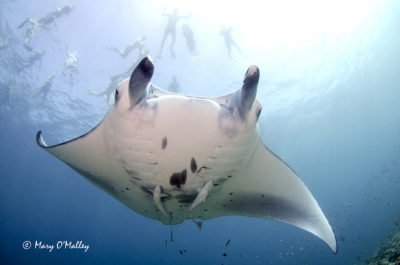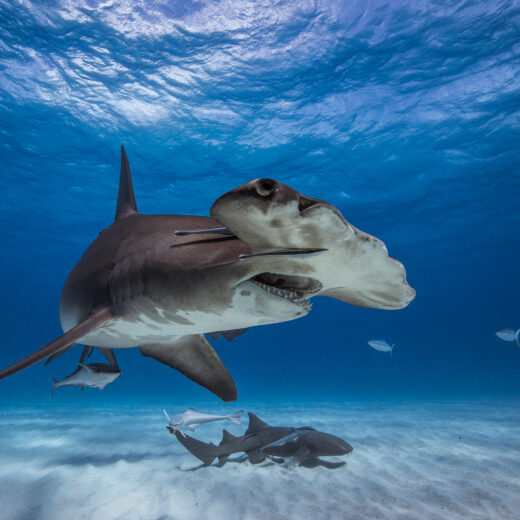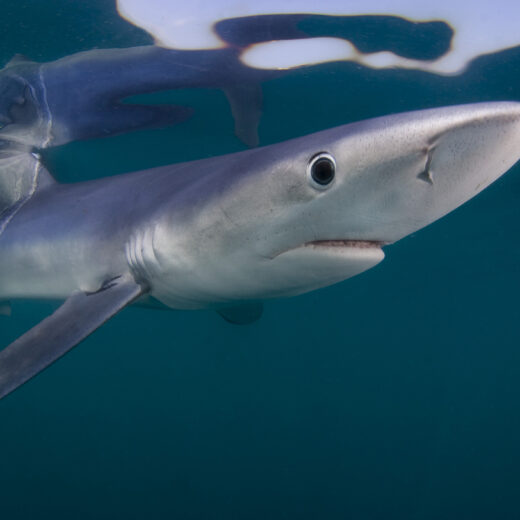
An important step, but more needed say conservationists
Geneva, Switzerland (September 14, 2014) – Protection under Appendix II of the Convention on International Trade in Endangered Species of Wild Fauna and Flora (CITES) kicks in this week for five more shark species and two manta ray species. Any trade in oceanic whitetip shark, porbeagle, scalloped hammerhead shark, smooth hammerhead shark, great hammerhead shark, and manta ray products is now to be restricted via national regulations to “avoid utilization incompatible with their survival.” The designation was passed at the CITES’ 16th Conference of the Parties in Bangkok, Thailand in March of 2013 and the listings go into effect this Sunday, September 14.
Many shark and both manta ray species have suffered drastic population declines in recent years due to commercial fishing, mainly to feed demand in China. An estimated 100 million sharks are killed every year with fins from up to 73 million used for shark fin soup. Some shark populations have declined by up to 98% in the last 15 years, and nearly one-third of pelagic (those that inhabit the open sea) shark species are considered threatened by the International Union for Conservation of Nature’s Red List of Threatened Species™.
Speaking on the occasion of the entry into force of these new listings, the Secretary-General of CITES, Mr. John E. Scanlon said: “Regulating international trade in these shark species is critical to their survival. Implementation will involve some challenges to ensure that this trade is legal, sustainable and traceable, and this will include practical issues such as identifying the fins and meat that are in trade. But by working together we can and will do it.”
“The complexity, scale and intensity of the threats to species underscores the need for partnership and coordination in achieving meaningful conservation goals such as is the case for sharks and mantas” said SOS Director Dr. Jean-Christophe Vié.
“Before this, Appendix II covered only three shark species, but CITES must still be effectively enforced and has to be paired with effective demand reduction in consuming nations. In the case of mantas, 90% of the gill plate trade is going through Guangzhou, China,” stated Peter Knights, WildAid Executive Director.
The “Manta Ray of Hope” campaign was led by WildAid, Shark Savers, and the Manta Trust with support and funding from SOS – Save Our Species. The campaign released the first comprehensive report about the global threat to manta and mobula rays, and a video that showcased the beauty of mantas as well as never before seen footage of the capture, slaughter and processing of the animals.
In China, WildAid, with the support of SOS – Save Our Species, has launched an awareness campaign modeled on the successful shark fin campaign featuring celebrity ambassadors such as Yao Ming, Jackie Chan and Maggie Q.
According to a June 2014 report from WildAid, “The Continuing Threat to Manta and Mobula Rays: 2013-14 Market Surveys, Guangzhou, China”, market volume of their gill plates increased by 126% between 2010 and 2013 in China, and now an estimated 150,000 manta and mobula rays (devil rays) are consumed yearly in Southern China. Mobula rays are not currently listed on any CITES Appendices.
Whereas shark fin is consumed in pricey bowls of soup as symbol of wealth and status, the gills from manta and mobula are being falsely marketed as a health tonic in China, where the dried gills can fetch up to $500 per kilogram. The practice has no health benefits, and is not recognized or documented by formal Traditional Chinese Medicine. Additionally, WildAid investigations found dangerous levels of arsenic, cadmium, mercury and lead in manta and mobula gill plate samples from the Guangzhou markets.
Targeted manta populations have declined by an estimated 56% to 88% in recent years. It takes 8-10 years for a manta to mature sexually and a female manta may give birth to only one pup every two to five years. Due to this slow reproduction they cannot sustain even modest fishing levels.
WildAid argues that mantas are worth far more alive to local communities than dead. In 2013, the total sale of manta and devil ray gills in Guangzhou was estimated at $30 million, with most of the financial benefit going to the distribution channel rather than fishermen. In contrast, coastal communities can benefit greatly from sustainable ecotourism around manta ray watching, which attracts more than an estimated US $140 million per year, globally.
WildAid is calling on Guangzhou authorities to implement the new CITES restrictions and to end the trade in both manta and mobula parts in order to protect both the public and the environment. WildAid is also working to support more range states to join Indonesia in banning the fishing of these highly vulnerable animals.
Stay in touch and get the latest WildAid updates.
SIGN UP


